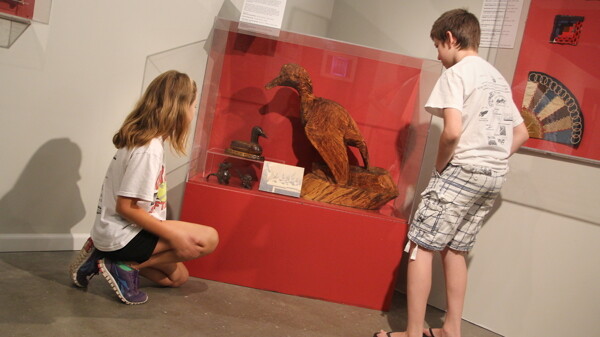Something to Folk About
new CV Museum exhibit highlights region’s folk art
Hope Greene, photos by Andrea Paulseth |

The brilliant thing about folk art is its liveliness. Folk art has a common life that high art lacks, its preciousness is a living one, in that the objects and skills occupy the everyday of life instead of being locked away out of regular life as too valuable to lose or to damage. It’s not the good china. The objects and skills of the folk arts exist by evolving, changing, chipping, and decaying along with the human beings who create and participate in them. The practitioners are often anonymous, the quality of the work is variable, and the impact of each work is very small; a group around a table is fed and will be hungry again, music is played and not recorded to be listened to again, a quilt is pieced and stitched and then worn through as it keeps sleepers warm every night. All of these conditions would be death to the fine arts, to gallery sales and investment collections, but the folk arts are a hearty, weedy section of the garden of arts and their brilliance is in their ability to seed absolutely everywhere with a small taste of excellence and a waft of the extraordinary.
In their preparation for the exhibit, the students arrived at the definition
of folk art as being, “the expression of shared beliefs, knowledge, skills and traditions passed down through generations.”
Art All Around is a new exhibit about the folk arts of the region at the Chippewa Valley Museum. The exhibit is designed to call attention to the manifestations of folk art here in the Chippewa Valley, and, by extension, in our modern everyday lives. The exhibit was curated by four UW-Eau Claire students, Wendy Guerra, Robin Kintner, Benjamin Niles, and Jessica Riege, as they served internships at the museum. In their preparation for the exhibit, the students arrived at the definition of folk art as being, “the expression of shared beliefs, knowledge, skills and traditions passed down through generations,” focusing the definition of arts as skills and knowledge rather than necessarily as artistic works. Based on this definition of folk art, the students each selected a concentration and created a section of the exhibit based on their own research and the objects they found in the museum collection. The four areas of the exhibit are food, music, handcrafts, and hunting.
The cultural groups producing folk art in the Chippewa Valley are varied and some sections of the exhibit offer a survey of various traditions’ folk arts while others focus more in-depth attention on a single culture’s expressions. At the front of the exhibit is an interactive wall where museumgoers can contribute stories of their own experiences with the folk arts. The section on food presents a broad picture of the many cooking and gardening traditions in Eau Claire and of the region, from the communal potluck to the sacred wild rice, using photographs, displays of tools, and firsthand stories. Likewise, the music section is a survey of various communities’ traditional musical styles and how those styles evolved during their history in the region. There is an array of musical instruments on display, many of them made by hand, while a video plays samples of the music they would have produced. Woodcraft is well-represented both in the music and the handcraft sections, reflecting the region’s abundance of forests as well as its history of logging. Among the standouts in the handcrafts exhibit are the unusual, sinuous pieces by the local blind woodcarver Harold Konrad. The other focus in handcrafts is on quilts, and there are several examples of historical quilts and quilting techniques including work by the late 19th century D.I.Z. Crazy Quilt Club of Eau Claire. The display on hunting seeks to represent the past century of local deer hunting through the tools used by hunters and a mix of historical and modern photographs.
Art All Around will be on display at the museum until March 31, 2014. Museum hours and directions can be found at www.cvmuseum.com or by calling (715) 834-7871.




















